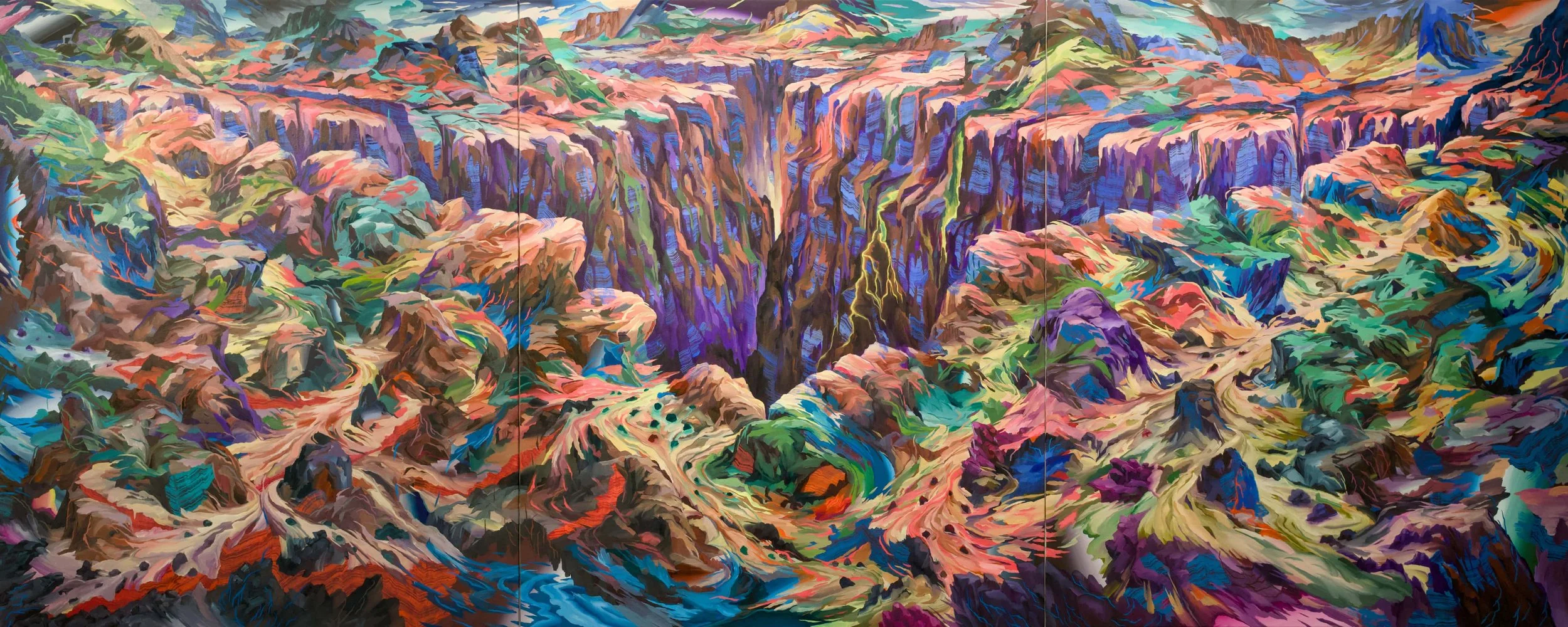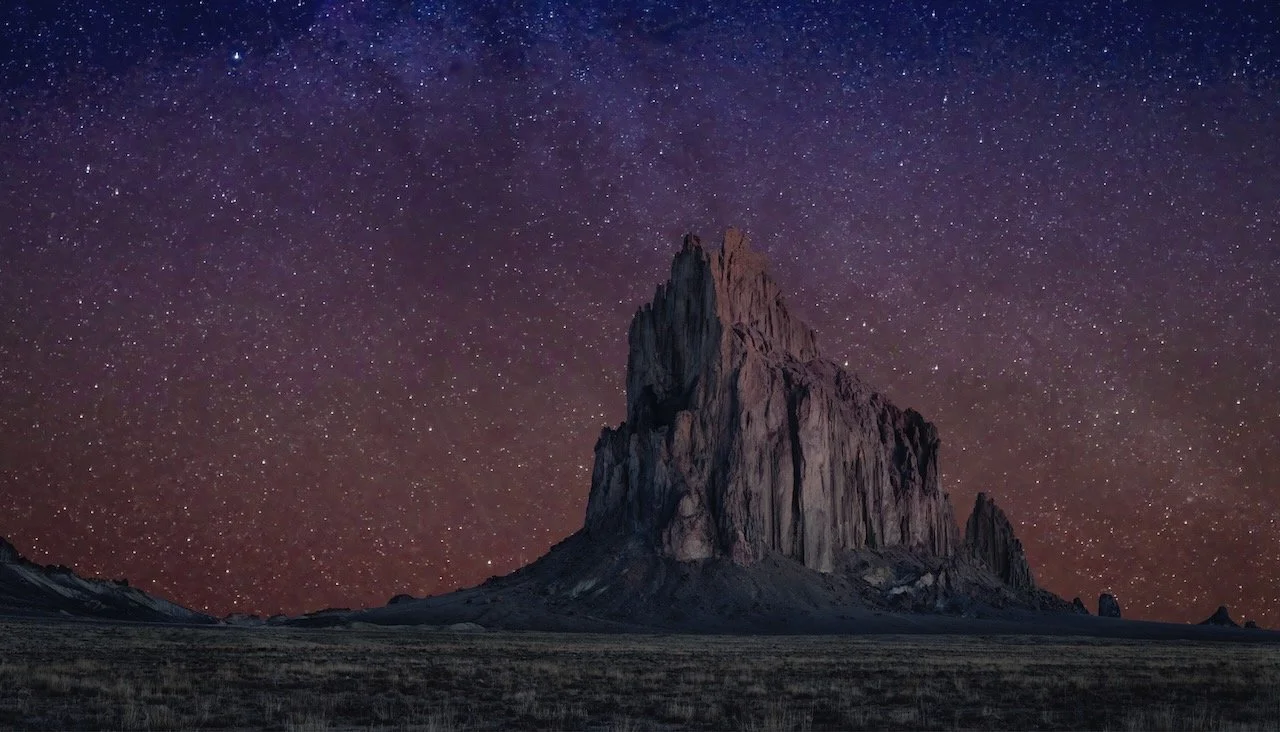Life on Mars
Scottsdale Museum of Contemporary Art
Scottsdale, AZ
The works in this exhibition “Life on Mars?” explore the space between earth and sky, the physical and the spiritual. Drawing from Diné stories, ancestral memory, and the natural forces that shape the land, each piece navigates layered geographies, both terrestrial and celestial. I often think about how time is not linear but cyclical, how knowledge lives not only in language but in the natural environments we live in.
I merge landscape, abstraction, and mythology to ask how we relate to place, and how place holds us in return. From sacred formations like Tsé Bitʼaʼí (Shiprock), to star constellations and river-carved canyons, I’m interested in how we trace meaning across land and sky. These are not simply images or objects, but maps of memory, myth, and lived experience.
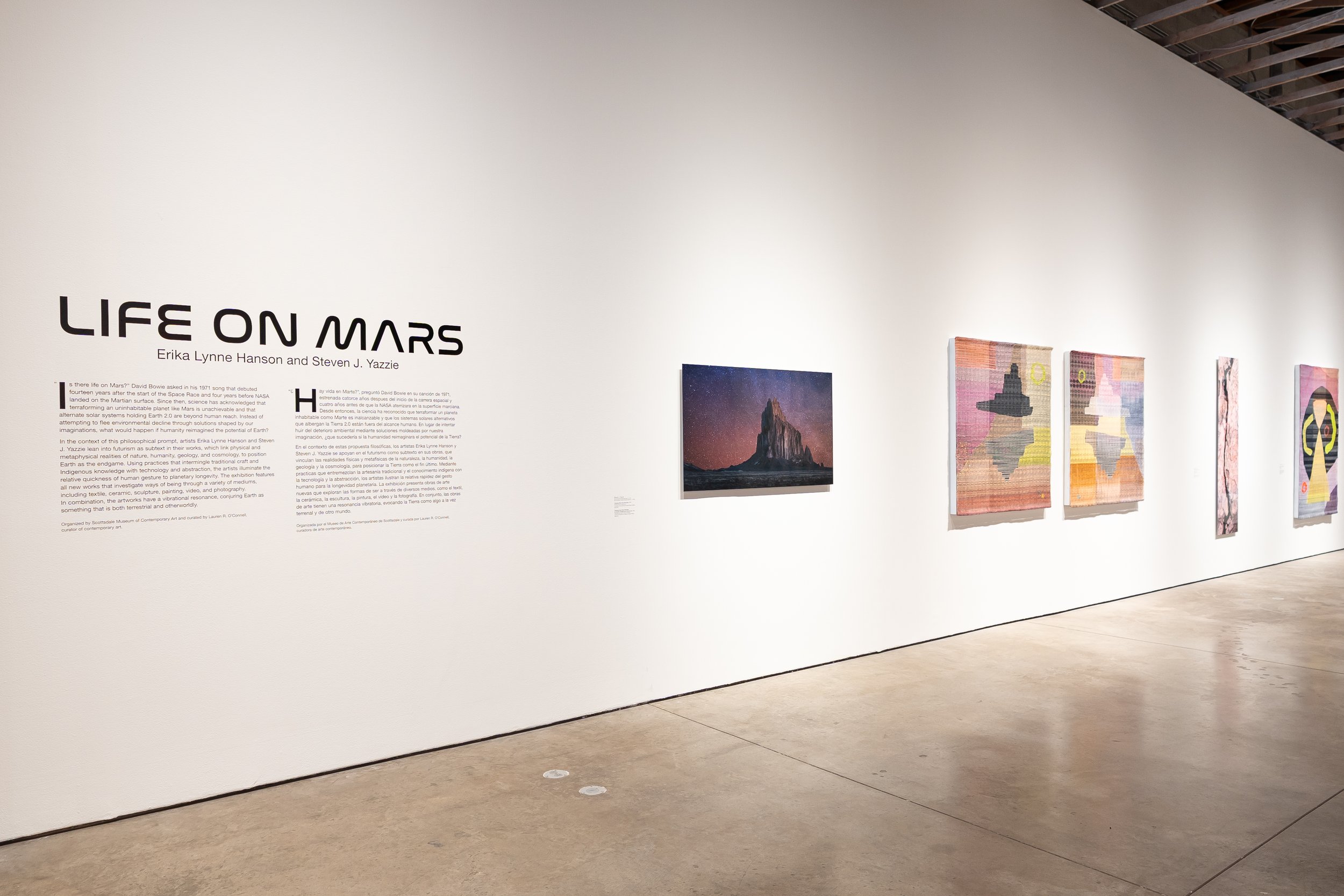
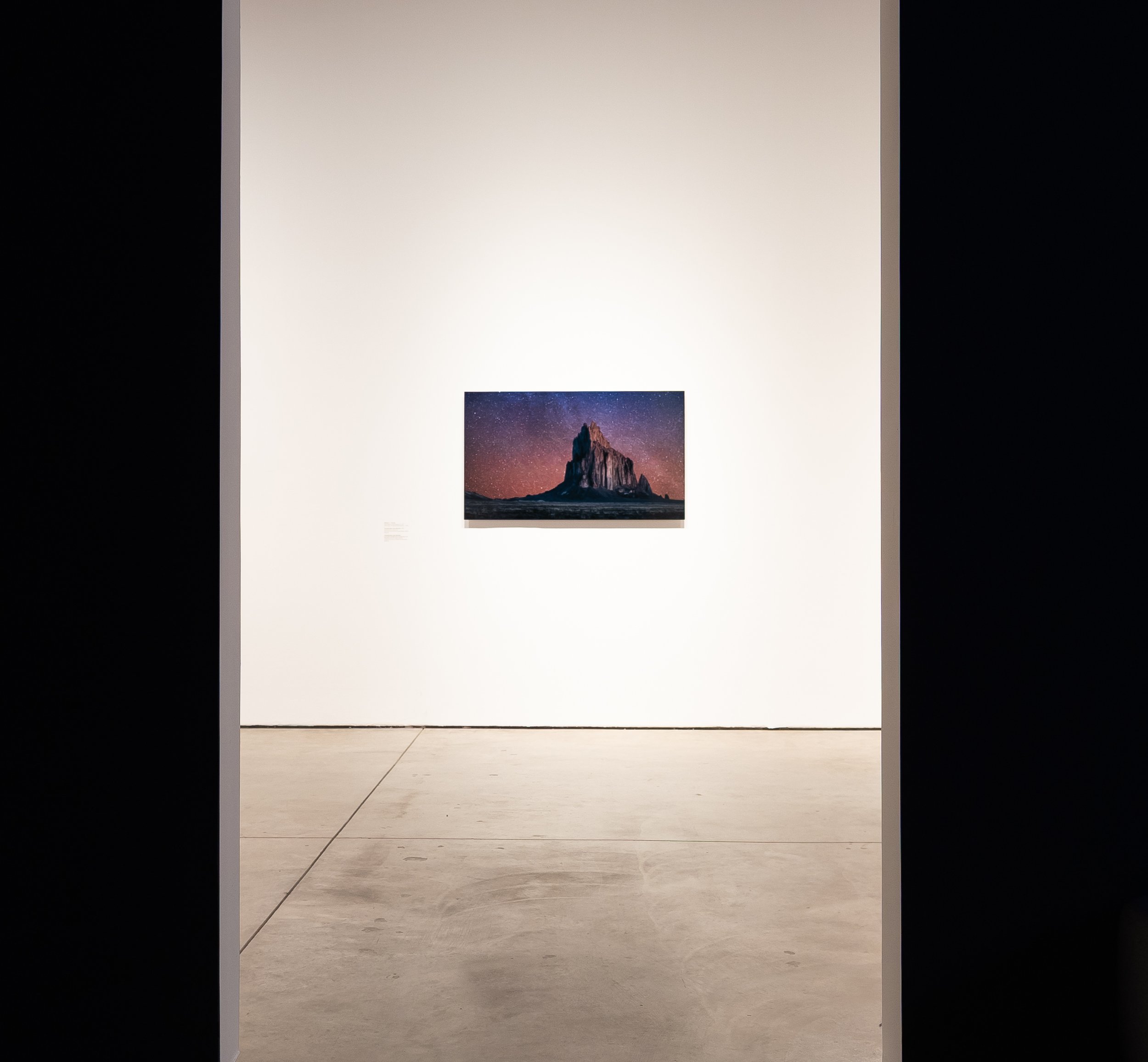
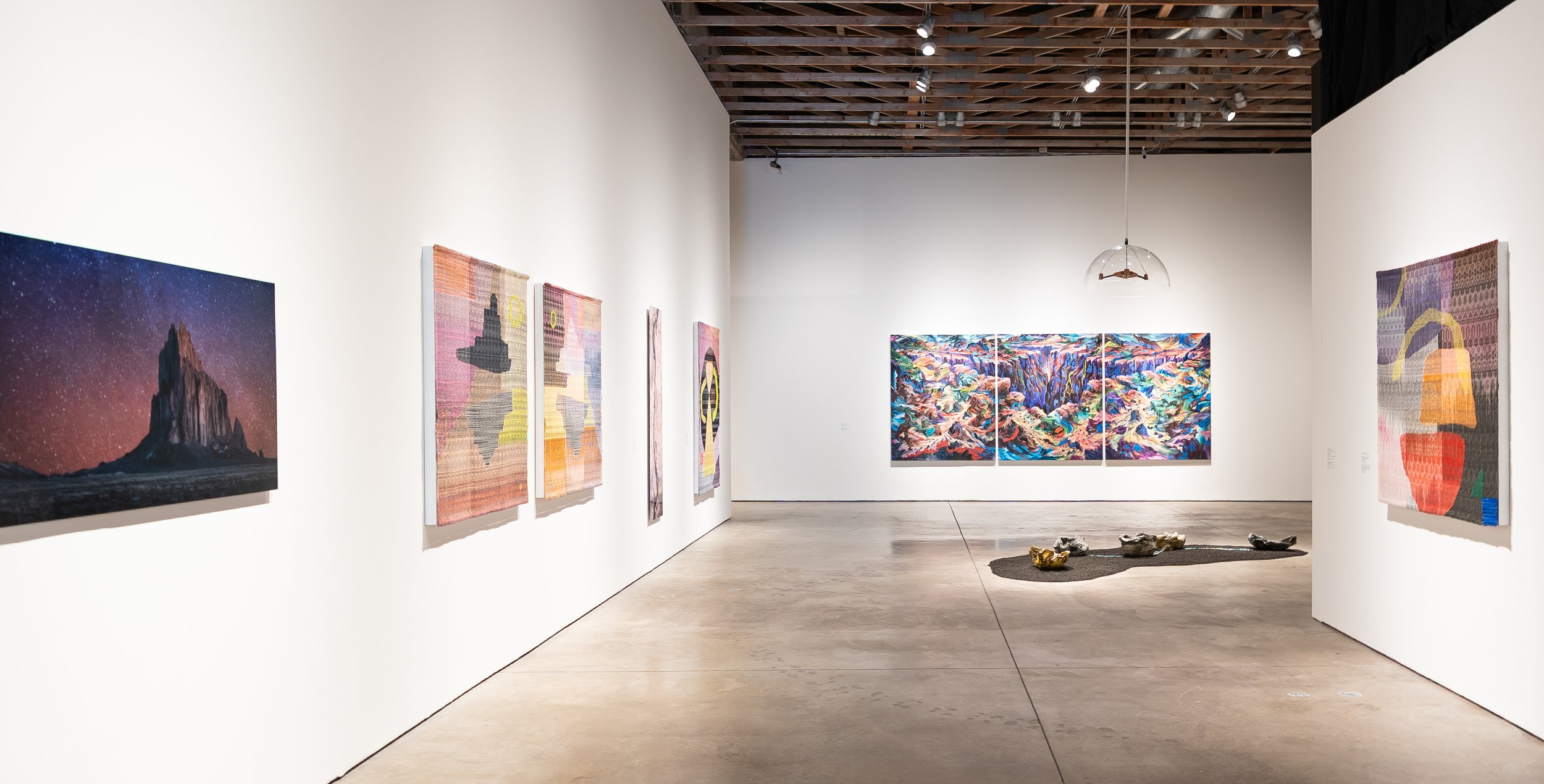
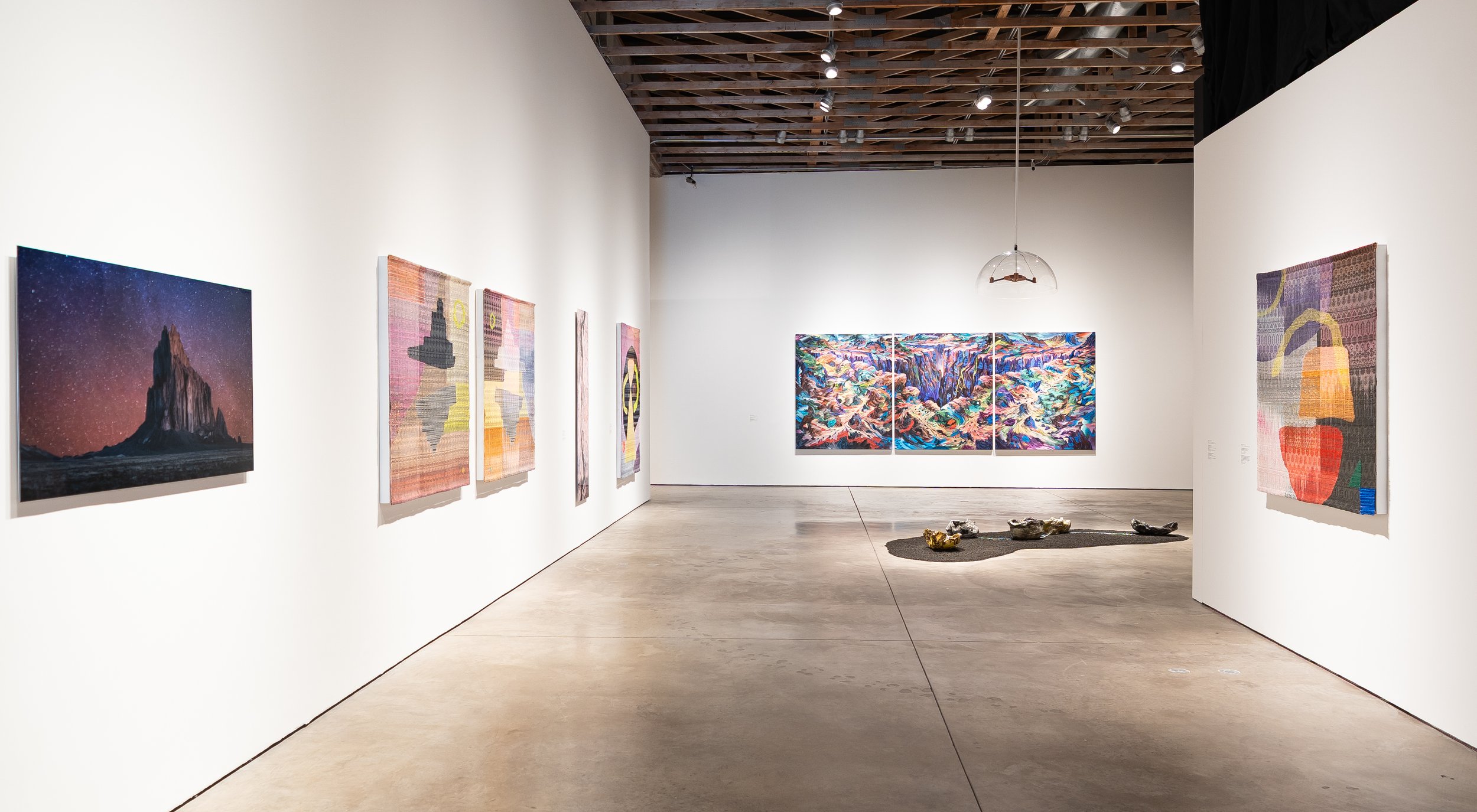
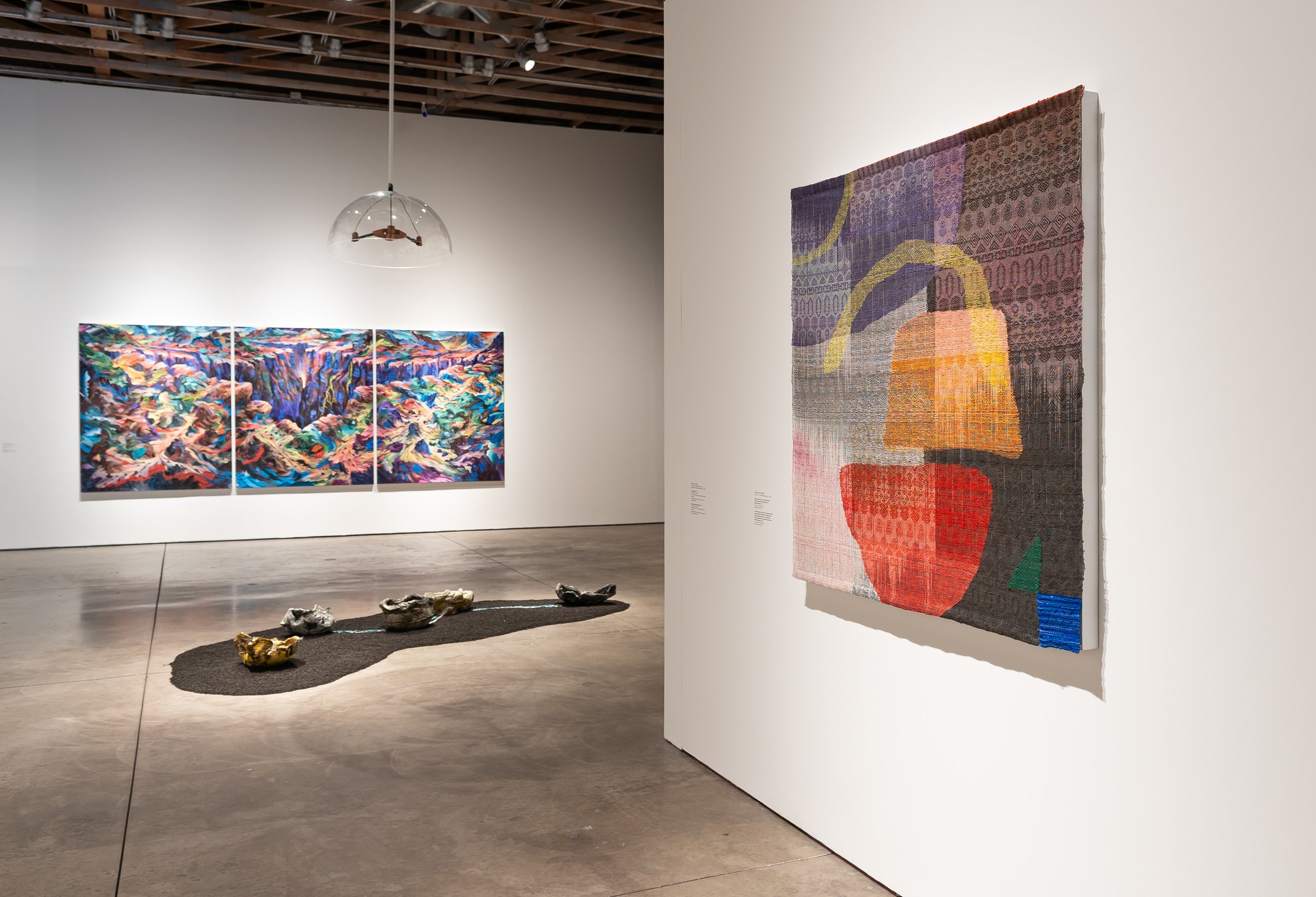
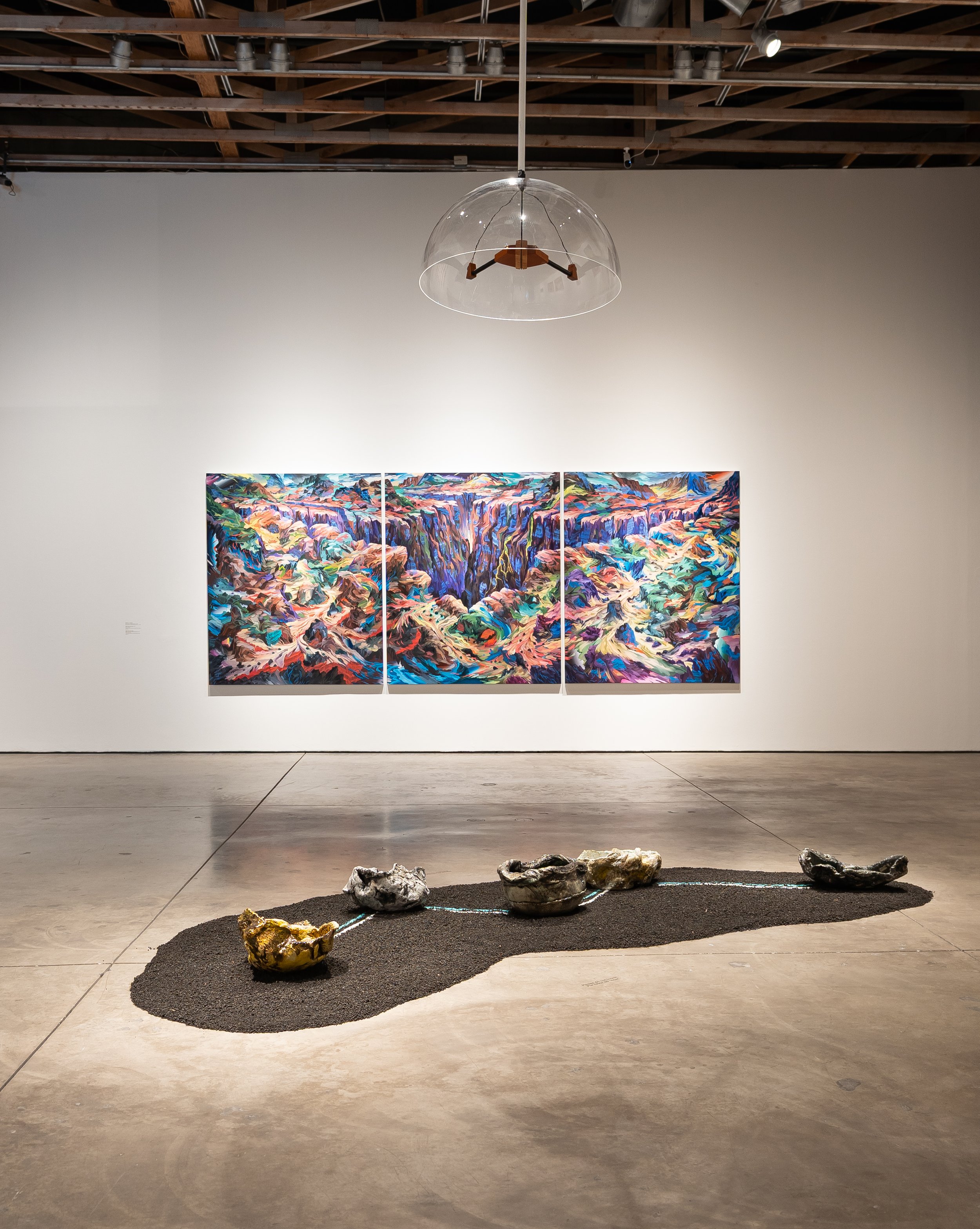
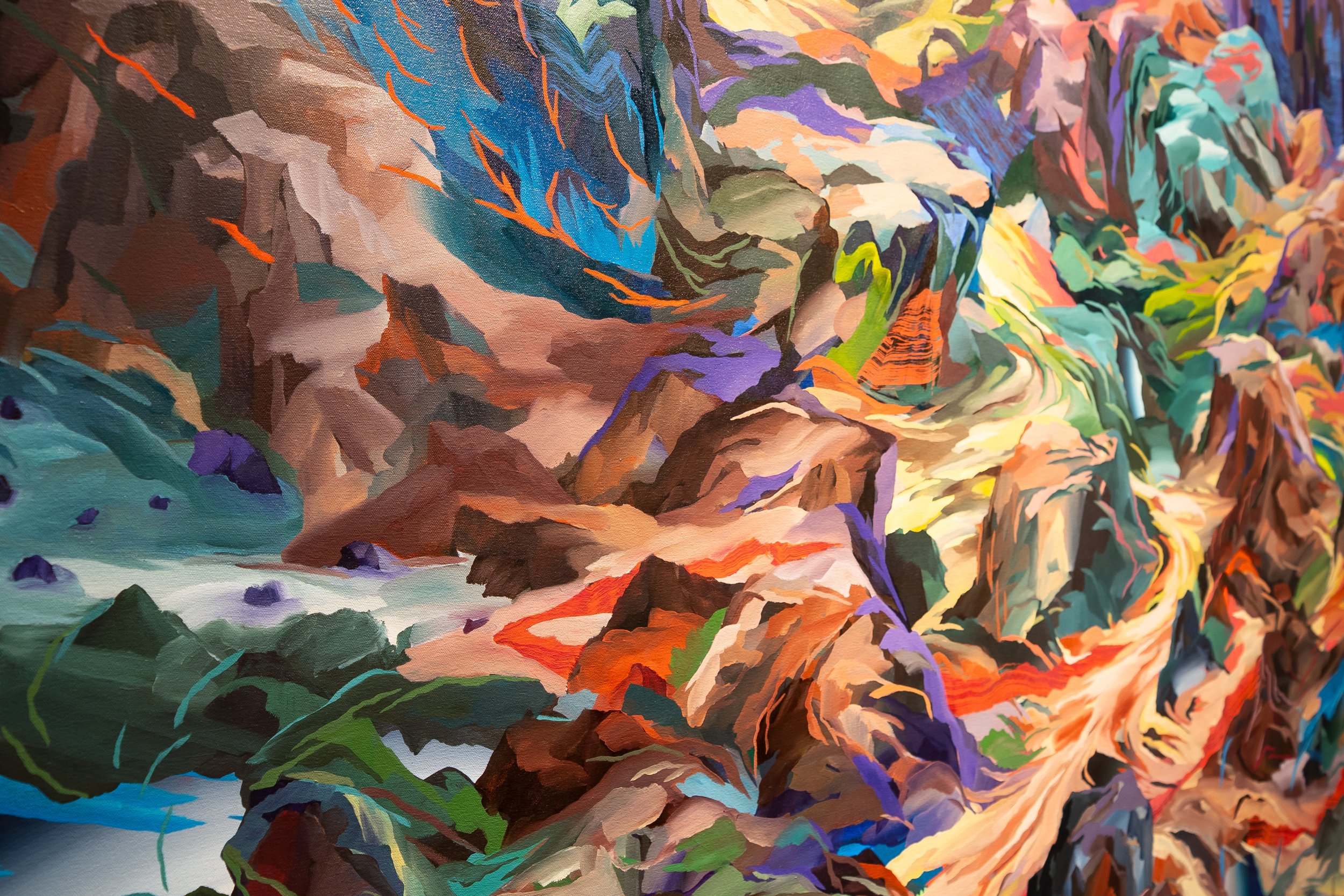
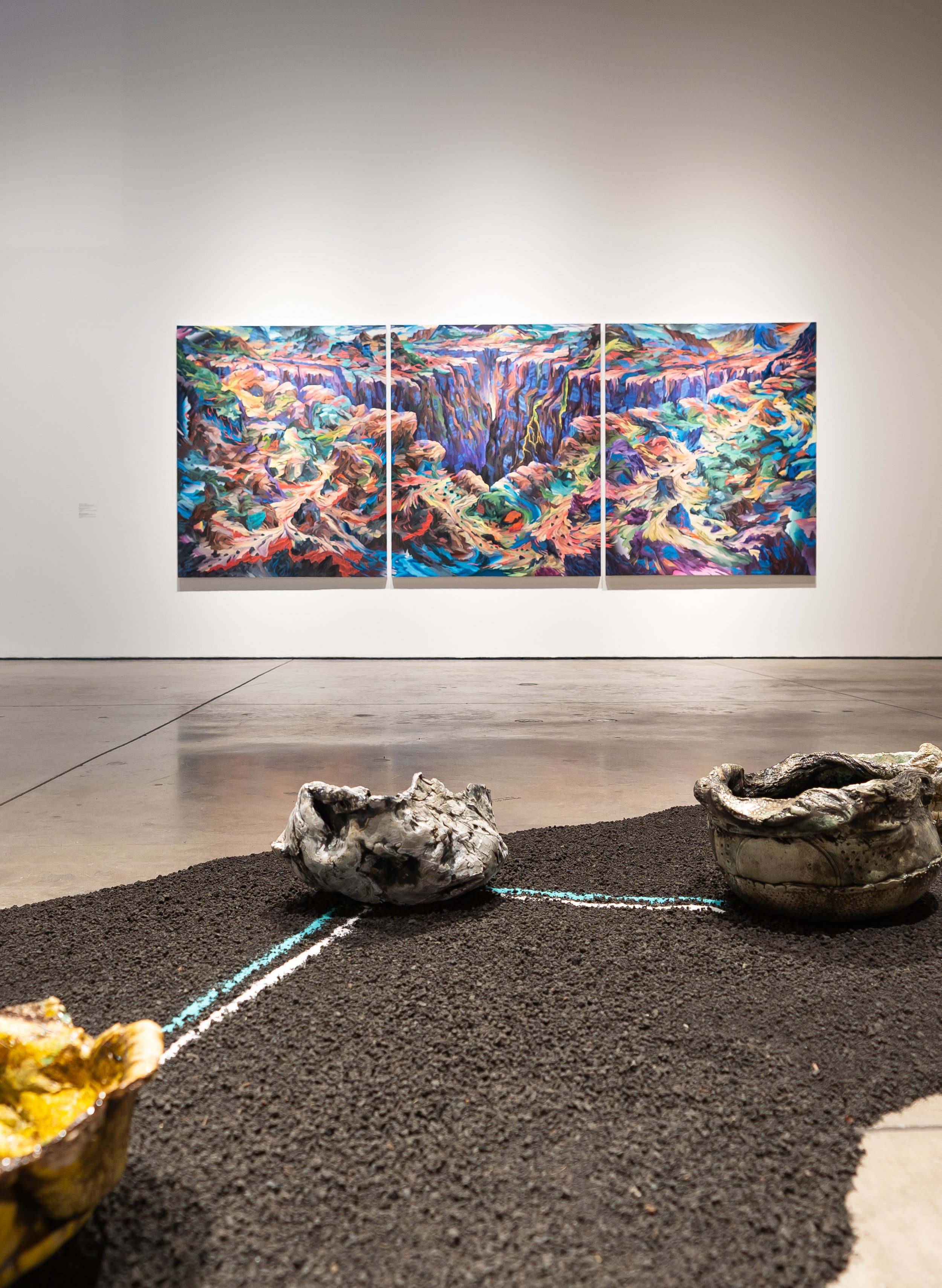
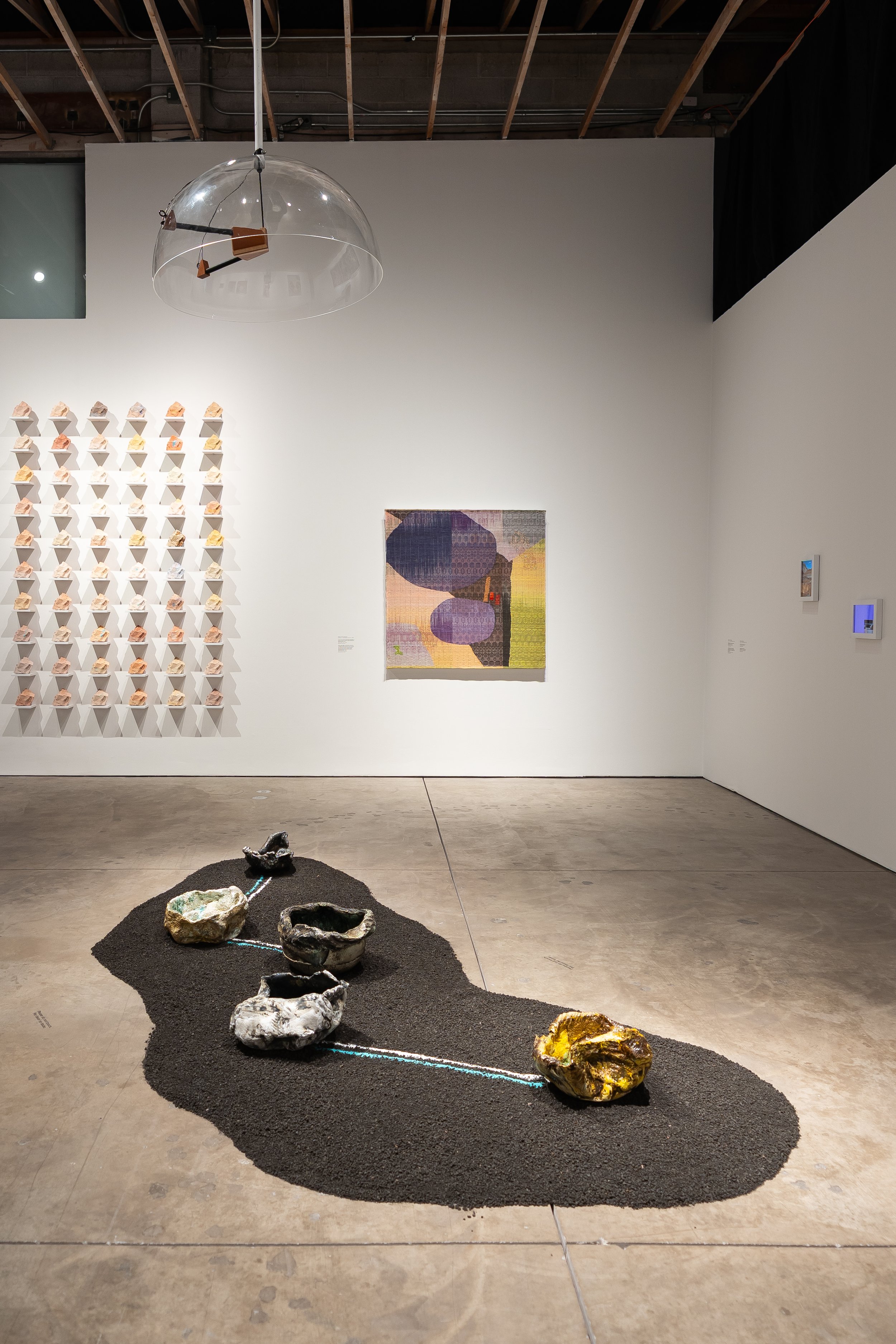
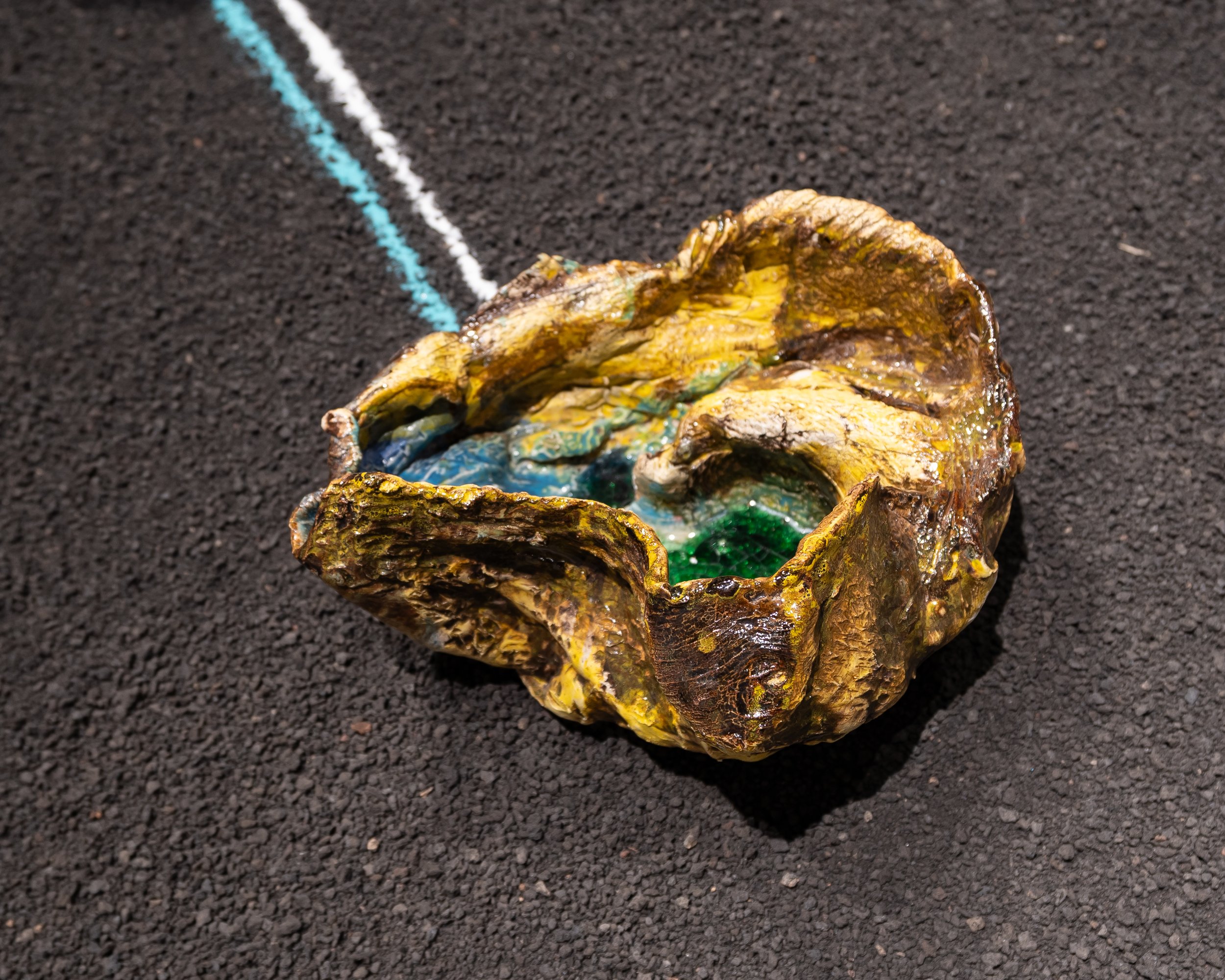
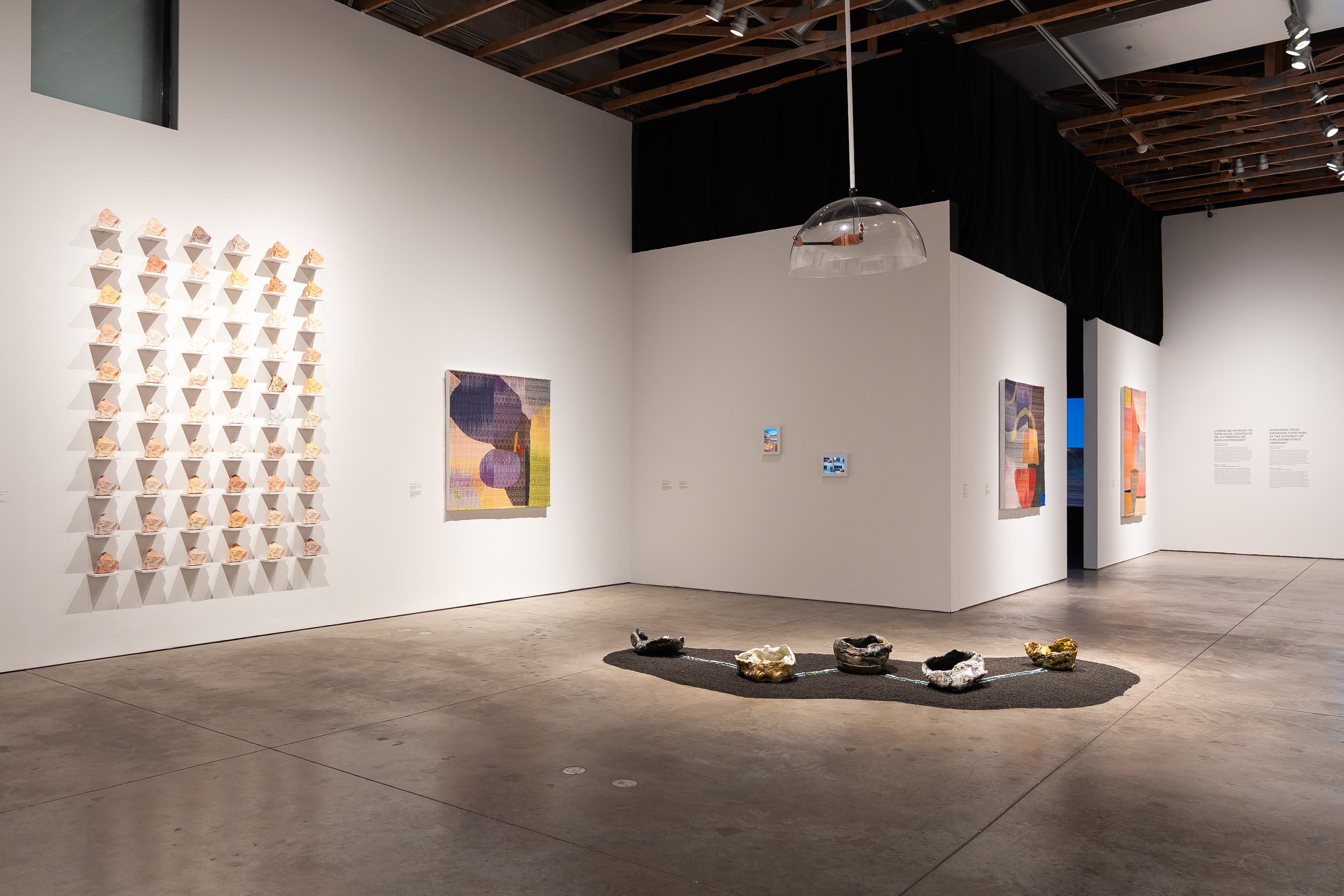
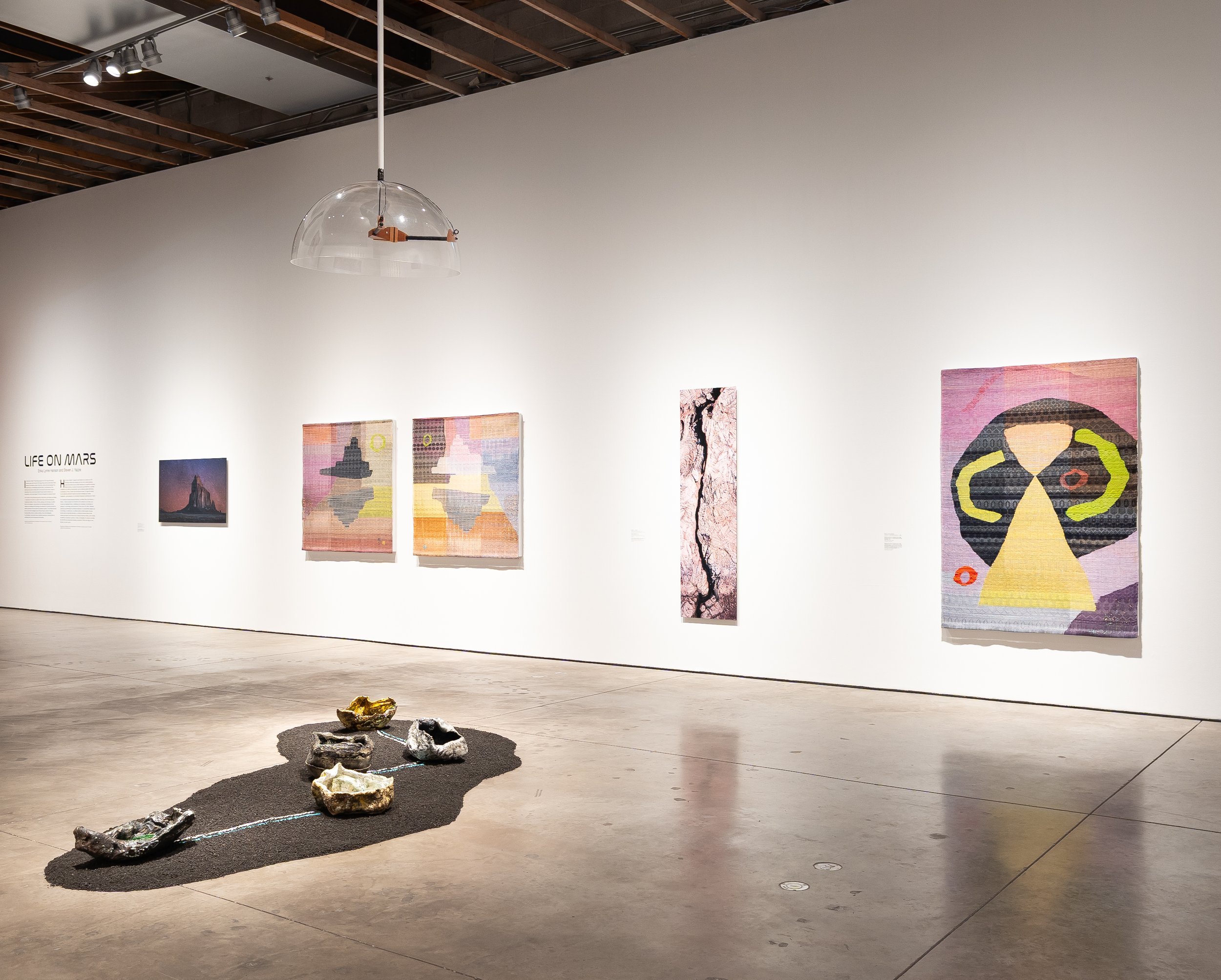
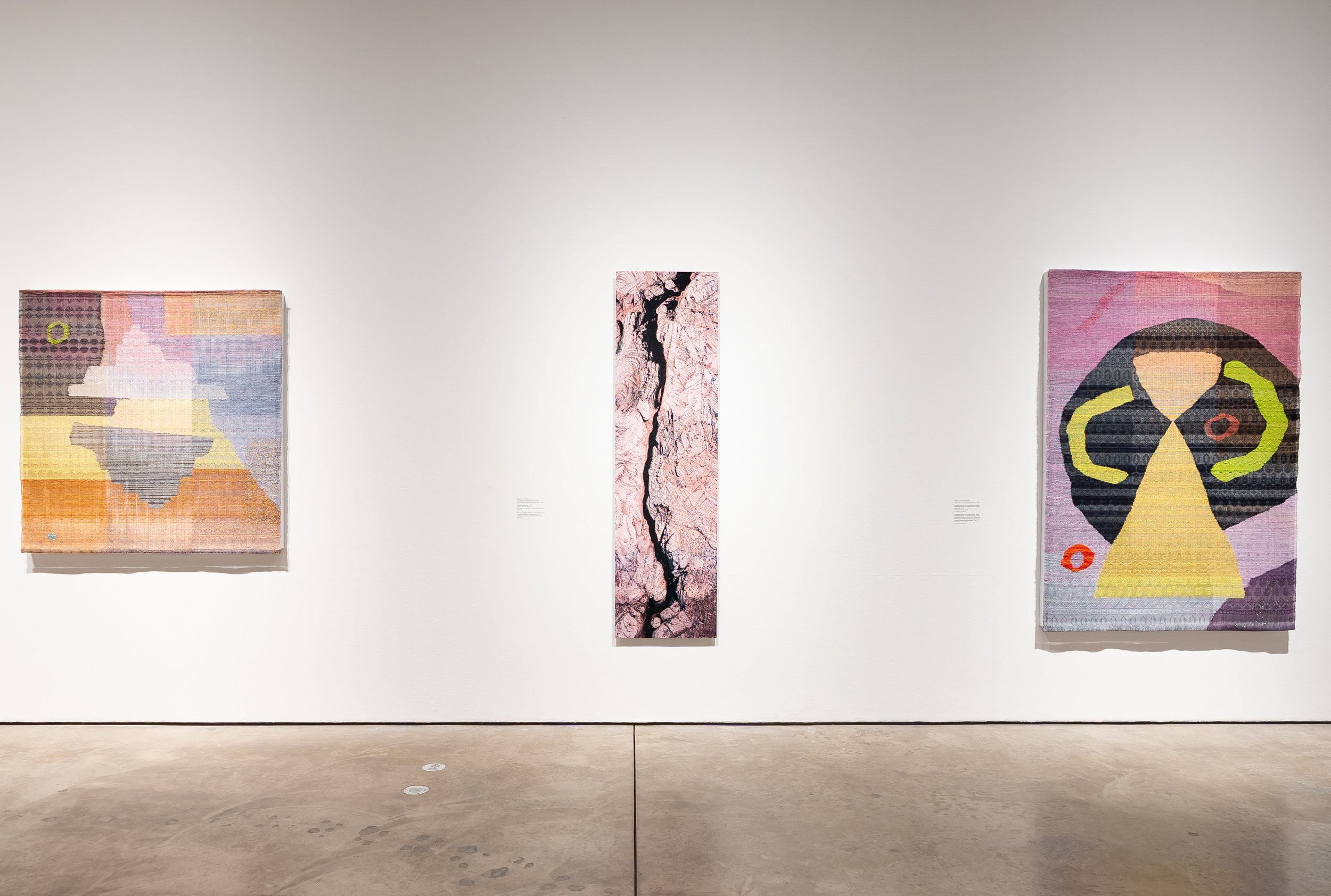
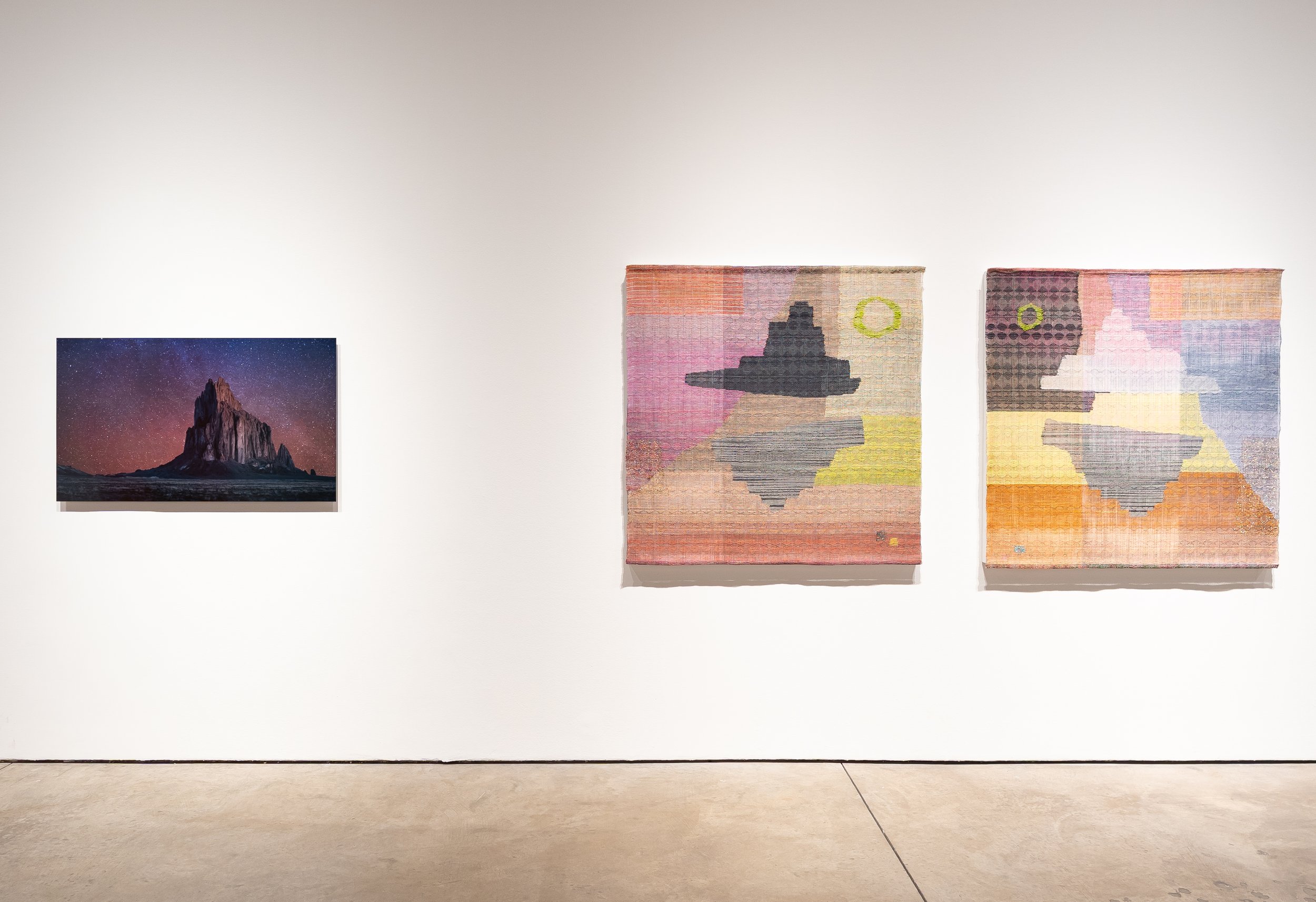
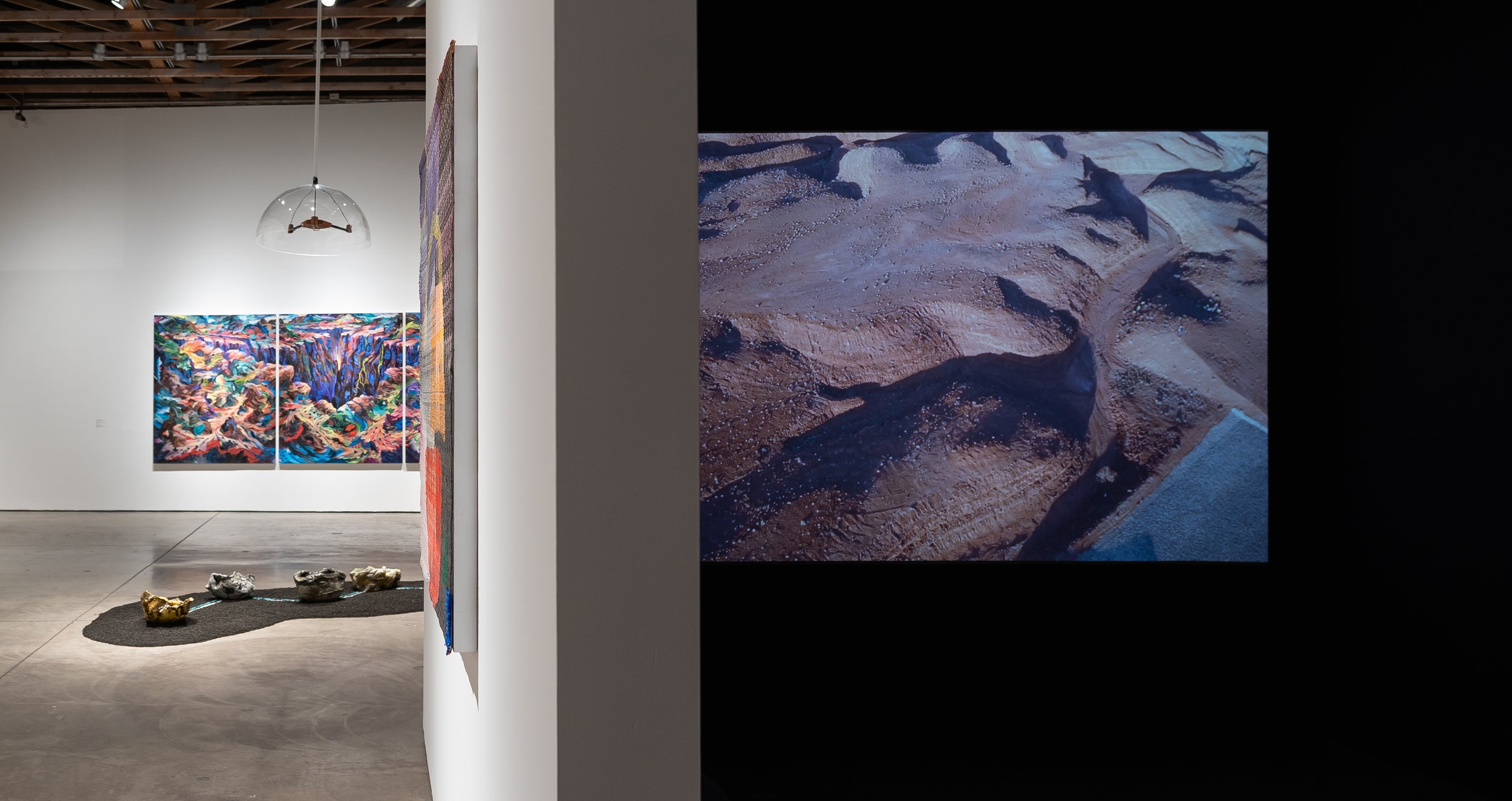
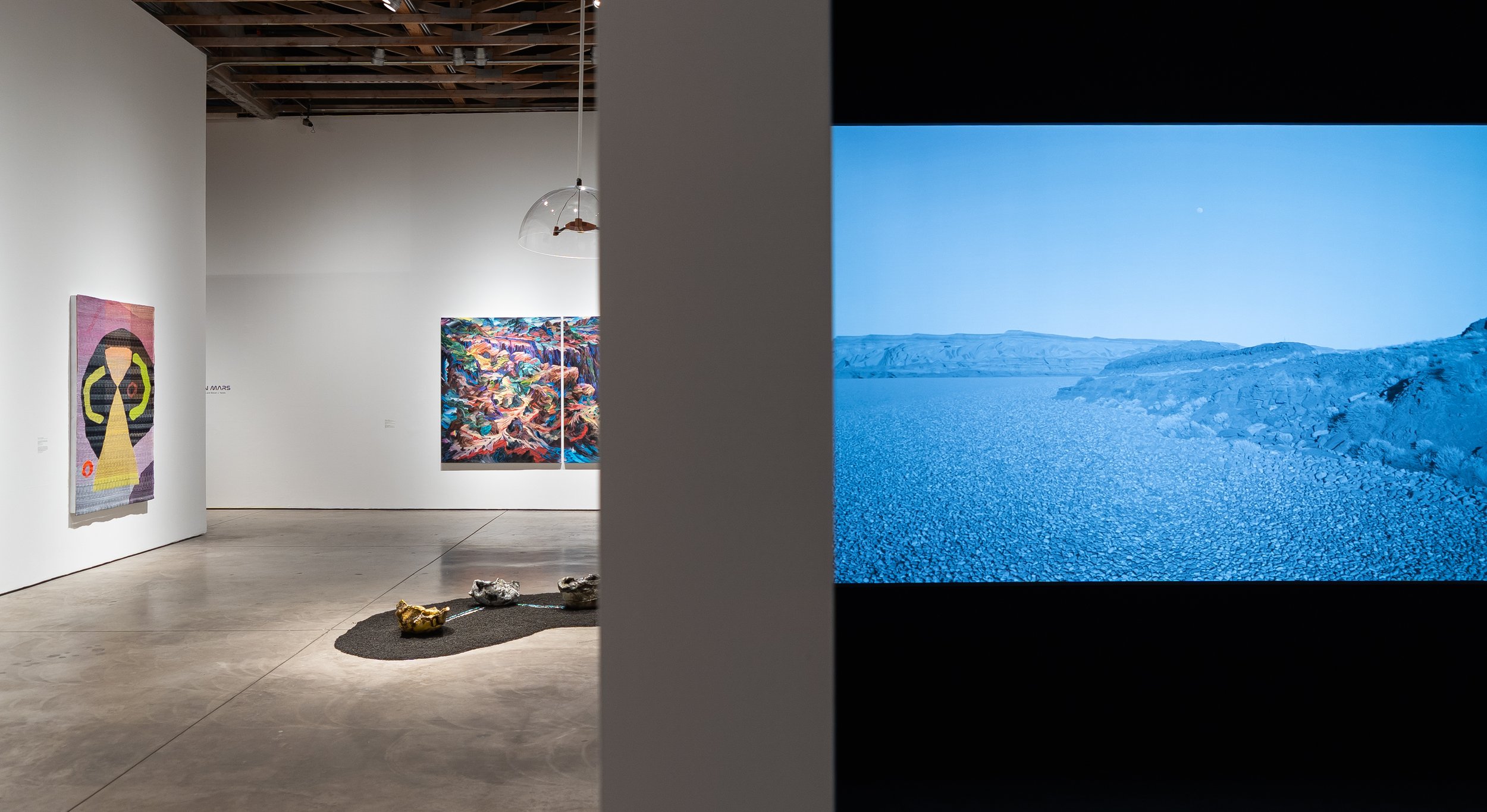
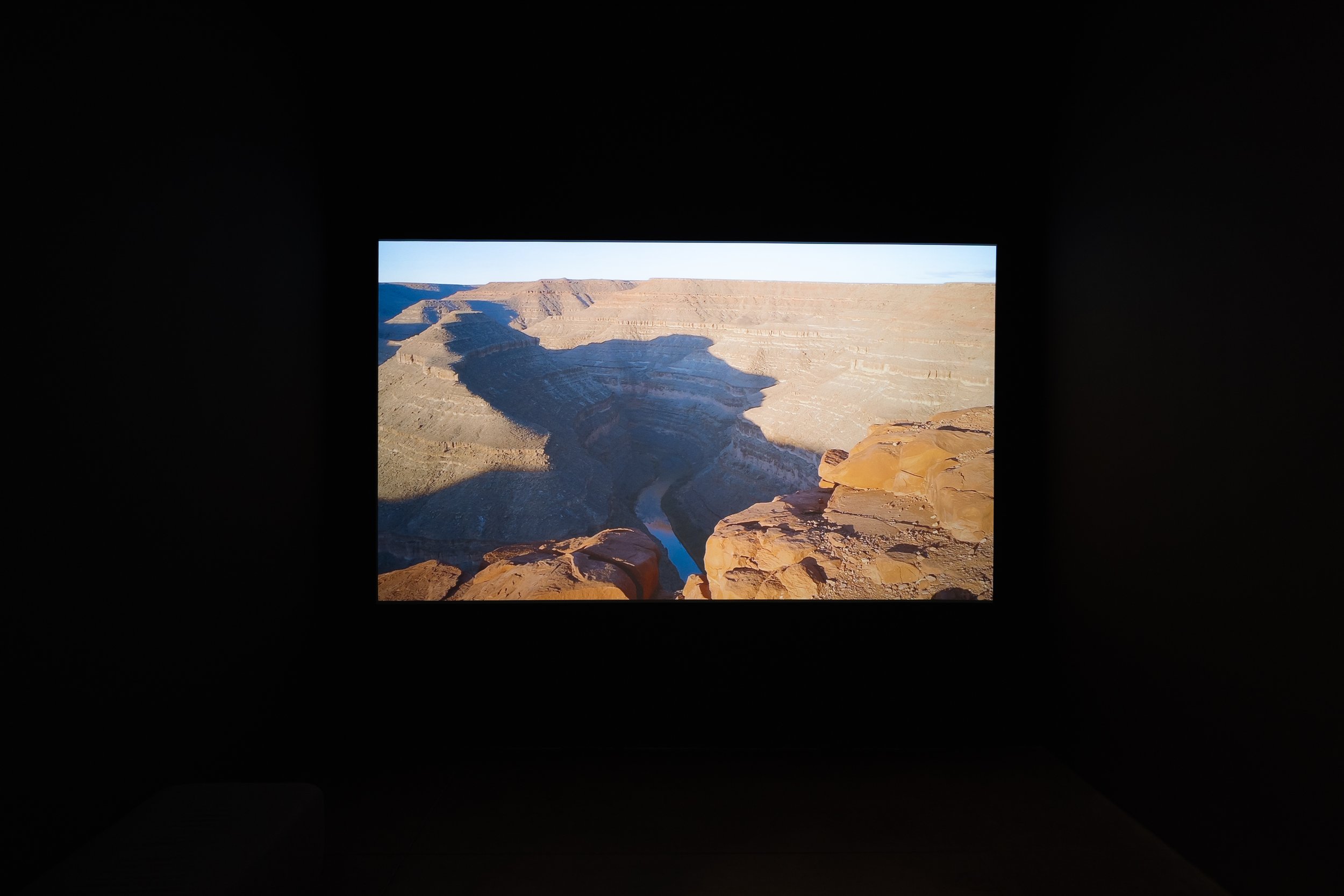
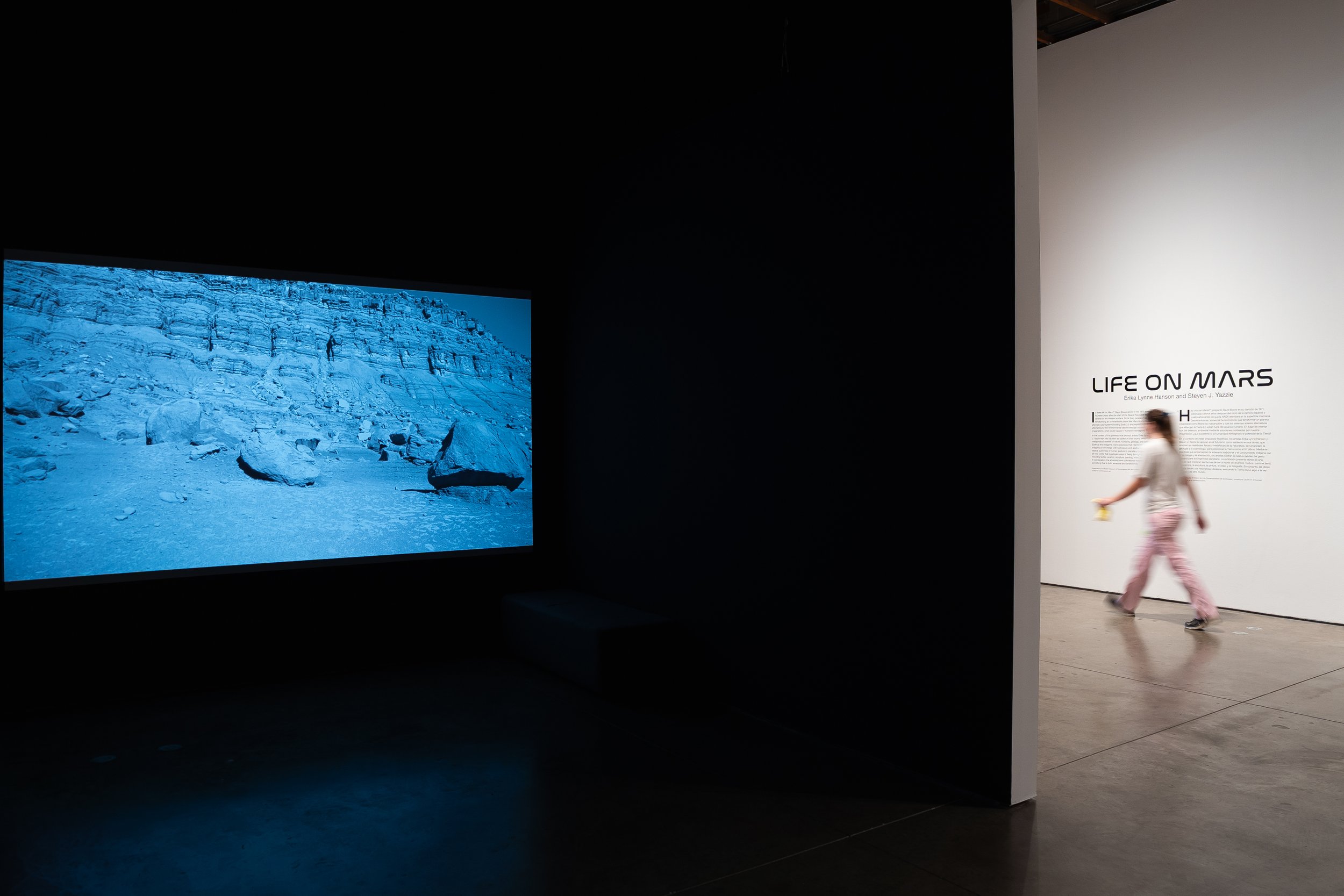
Night-Dawn-Day-Dusk, oil on canvas; 180 x 72 inches, 2025
A monumental triptych, Night-Dawn-Day-Dusk unfolds as a vibrant abstracted landscape moving through temporal states, echoing planetary cycles. The painting exists as a non-place, an imagined or reimagined memory, where instinctive mark-making manifests as a visual record of form in flux. Throughout the painting, vignettes reveal the visual interplay between flat abstraction and naturalistic arrangements. The title itself suggests the cyclical nature of time. It also acknowledges concepts of cultural balance. Abstract compositions can mirror the structure of indigenous systems that are nonlinear, relational, and interconnected. For example, color may allude to sacred directions, or times of day. Time may be conveyed as a moving splash of color rather than a line, and spatial arrangements may reflect constellations or spaces of meditations. Rather than presenting a singular viewpoint, abstraction invites multiple readings, mirroring the layered ways in which knowledge is held and transmitted.
Moreover, abstraction, in its resistance to fixed form and literal representation, opens a space for what can be imagined, remembered, or intuited rather than seen. In Indigenous contexts, particularly within Diné (Navajo) thought, abstraction is not a departure from reality but a means of accessing a deeper, layered reality that includes memory, ceremony, cosmology, and ancestral knowledge. It can function as a visual language for the unseen: the movement of wind across a mesa, the shape of a prayer, or the cyclical rhythm of time as experienced through seasons, light, and land.
Constellation - Ceramics, earth, sound; Variable dimensions, 2025 (Ceramic objects created with Michael Prepsky)
The floor installation titled, Constellation, grounds the cosmic in the terrestrial, drawing from both Greek and Navajo mythology. Five ceramic vessels arranged in the pattern of Cassiopeia and its Navajo counterpart, Náhookos Bi'áadii ("Northern Female"), rest on volcanic stone and are visually connected with colored sand (white and turquoise), linking earthbound materials with celestial mapping, blending cosmology, cultural stories, and physical materials to explore themes of belonging and our place within the universe. Additionally, there's sound playing over the floor arrangement. The rhythmic sonic patterns were created from each ceramic object as a singular instrument further expanding the context of the work as a multi-sensory experience that bridges the physical and spiritual realms linking earthbound materials with celestial mapping.
Cassiopeia and Náhookos Bi'áadii, while representing the same constellation, are archetypically different due to their cultural contexts. Cassiopeia is a figure from Greek mythology, often depicted as a queen known for her vanity, while Náhookos Bi'áadii, "Northern Female," from Navajo cosmology, is the "mother of the home" and embodies values of family, protection, and the domestic sphere. Therefore, the difference lies in their respective archetypal roles. The implications and juxtaposition of Cassiopeia and Náhookos Bi'áadii creates an intercultural dialogue. It suggests that art can be a space for exploring and comparing different cultural perspectives on the same phenomena. This can lead to a deeper understanding of diverse worldviews and challenge ethnocentric biases
Throwing Stars Over Monsters, Archival Print on Aluminum; 48 x 28 inches, 2023
Throwing Stars Over Monsters reimagines the space between earth and sky through a cultural and mythological lens, merging Diné origin stories. The work draws on narratives surrounding Tsé Bitʼaʼí ("rock with wings" or "Shiprock"), a sacred site linked to both deliverance and conflict. One story recounts the twin warrior sons of Changing Woman, who defeated a monstrous bird atop the rock, transforming her fledglings into the first eagle and owl. Another speaks of the land itself rising like a wave to carry the Diné to safety, leaving behind the iconic winged formation. These terrestrial stories are paired with a celestial one: Coyote, the trickster figure, impatient with the slow order of the Holy Beings, hurls a bag of crystals into the sky, scattering stars in a chaotic, creative act that gave birth to the Milky Way. This image of disruption and creation resonates deeply with how I consider Shiprock and the surrounding area, where structured intent meets instinct and innovation. The photograph becomes a metaphorical map, one shaped by ancestral memory, and cosmic disorder into balance.
Points in Between - Archival Print on Aluminum; 20 x 72 inches, 2025
This composite aerial image captures a winding slot canyon incision through desert sandstone, revealing the layered record of geological time and erosion. Meandering through the center of the canyon, a black ribbon of stars threads like a river, subverting the expectation of shadow or water and replacing it with the cosmos. This surreal gesture introduces a metaphysical dimension. Constructed from multiple high-resolution images, the piece emphasizes the mirrored textures and uncanny symmetry of the rock formations, creating a sense of suspended scale between the real and the imagined.
The compression of time is central to this work. The landscape becomes not only a record of terrestrial history but also a stage for celestial memory. By embedding the night sky within the canyon floor, the image proposes a narrative of intersection: one that moves horizontally across the land, and another that reaches vertically into the stars. What would normally be perceived as opposites; earth and sky, day and night, are sutured together in a single, contemplative gesture.
Eyedazzler - video, sound ; 8-minute duration, variable dimensions, 2025
The two-channel video installation Eyedazzler, filmed in the northwestern region of the Navajo reservation where I grew up. Layers, movement, color, and texture evoke ancestral geographies and geometries that feel both familiar and otherworldly. Accompanied by distorted and manipulated field recordings, the work carries a sonic atmosphere that is ambient, industrial, and pensive. Some of the locations featured in the video correspond to areas in Diné Bikéyah (Navajo land) where uranium deposits and the legacy of resource extraction remain embedded in the landscape. These scars are subtle yet persistent, echoing through the terrain. Water and river systems appear throughout the video as both entry and exit points as a concept of continuity, passage, and renewal. The cycle of water through this region becomes a subtext for movement and transformation, reflecting its essential role in shaping the physical and spiritual architecture of the land.

